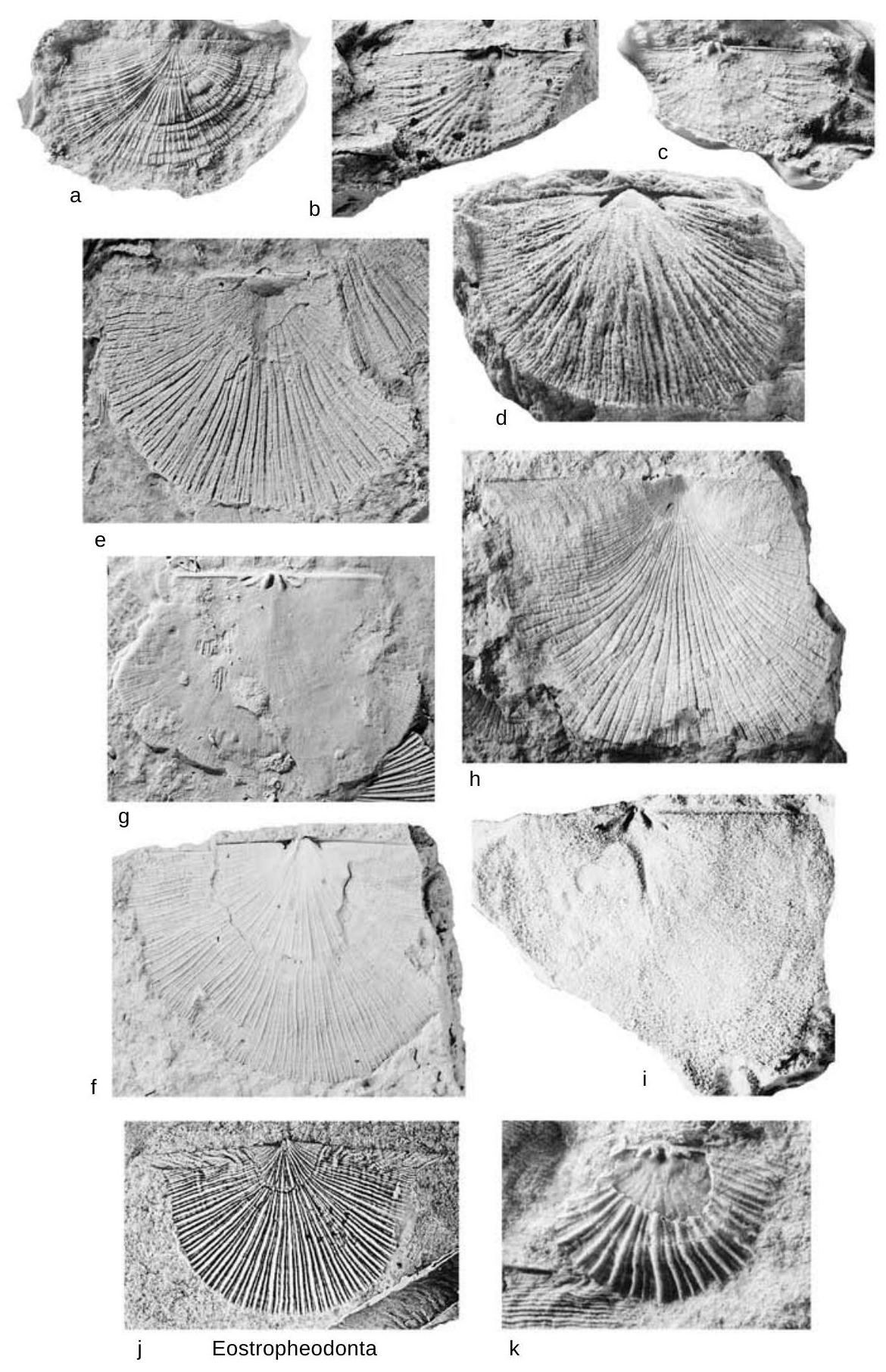Welcome to the Treatise on Invertebrate Paleontology!
Please enter a genera name to retrieve more information.

Eostropheodonta
Classification
Phylum:
Brachiopoda
Subphylum:
Rhynchonelliformea
Class:
Strophomenata
Order:
Strophomenida
Superfamily:
Strophomenoidea
Family:
Leptostrophiidae
Formal Genus Name and Reference:
Eostropheodonta BANCROFT, 1949, p. 9
Type Species:
Orthis hirnantensis M'COV, 1851, p. 395, OD
Images
(Click to enlarge in a new window)
Fig. 181a-d. *E. hirnantensis (M'Coy), Ashgill, a, latex of dorsal exterior, Husbergøya Formation, Rambergøya, Oslo, Norway, BMNH BB 93972, X1.5, b, c, dorsal internal mold, latex cast, Husbergøya Formation, Rambergøya, Oslo, Norway, BMNH BB 94003, X2, d, ventral internal mold, Hirnant Formation, Aber Hirnant, near Bala, Gwynedd, Wales, BMNH B 89573, ×1.5 (new).-Fig. 181e-g. *E. schmalenseei (Bergström), lower Dalmanitina Beds, Ashgill, e, latex cast of external mold of conjoined valves, Stommen, Västergötland, Sweden, LO 4249, X1.5 (Bergström, 1968), f, ventral internal mold, Stommen, BMNH B 90684, ×1 (new), g, holotype, latex cast of dorsal internal mold, Allebergsände, Västergötland, Sweden, LO 4248, X1 (Bergström, 1968).-Fig. 181h, i. *E. martnai (Röömusoks), Adila Formation, Pirgu Stage, Ashgill, Härküla, Aruküla, Estonia, h, ventral external mold, GMUT Br 1492, X1, i, dorsal internal mold, GMUT Br 1477, ×1 (Rõõmusoks, 1993c).
Synonyms
Aphanomena, Eoleptostrophia, Neokjaerina
Geographic Distribution
cosmopolitan
Age Range
Beginning Stage in Treatise Usage:
Ordovician (Ashgill)
Beginning International Stage:
Katian
Fraction Up In Beginning Stage:
66.7
Beginning Date:
447.72
Ending Stage in Treatise Usage:
Silurian (Wenlock)
Ending International Stage:
Homerian
Fraction Up In Ending Stage:
100
Ending Date:
426.74
Description
Planoconvex to gently concavoconvex profile, ornament variable from unequally parvicostellate to fascicostellate, sometimes in the same population, small denticular plates with few denticles, no denticles on the hinge line, short but strong dental plates present, with crenulations, ventral process generally absent, muscle field in both valves obscure or faintly impressed, erect cardinal process lobes elongate, separated at their bases, socket ridges widely divergent, dorsal septa absent
References
Museum or Author Information
Classification
Phylum:
Brachiopoda
Subphylum:
Rhynchonelliformea
Class:
Strophomenata
Order:
Strophomenida
Superfamily:
Strophomenoidea
Family:
Leptostrophiidae
Formal Genus Name and Reference:
Eostropheodonta BANCROFT, 1949, p. 9
Type Species:
Orthis hirnantensis M'COV, 1851, p. 395, OD
Images
(Click to enlarge in a new window)
Fig. 181a-d. *E. hirnantensis (M'Coy), Ashgill, a, latex of dorsal exterior, Husbergøya Formation, Rambergøya, Oslo, Norway, BMNH BB 93972, X1.5, b, c, dorsal internal mold, latex cast, Husbergøya Formation, Rambergøya, Oslo, Norway, BMNH BB 94003, X2, d, ventral internal mold, Hirnant Formation, Aber Hirnant, near Bala, Gwynedd, Wales, BMNH B 89573, ×1.5 (new).-Fig. 181e-g. *E. schmalenseei (Bergström), lower Dalmanitina Beds, Ashgill, e, latex cast of external mold of conjoined valves, Stommen, Västergötland, Sweden, LO 4249, X1.5 (Bergström, 1968), f, ventral internal mold, Stommen, BMNH B 90684, ×1 (new), g, holotype, latex cast of dorsal internal mold, Allebergsände, Västergötland, Sweden, LO 4248, X1 (Bergström, 1968).-Fig. 181h, i. *E. martnai (Röömusoks), Adila Formation, Pirgu Stage, Ashgill, Härküla, Aruküla, Estonia, h, ventral external mold, GMUT Br 1492, X1, i, dorsal internal mold, GMUT Br 1477, ×1 (Rõõmusoks, 1993c).
Synonyms
Aphanomena, Eoleptostrophia, Neokjaerina
Geographic Distribution
cosmopolitan
Age Range
Beginning Stage in Treatise Usage:
Ordovician (Ashgill)
Beginning International Stage:
Katian
Fraction Up In Beginning Stage:
66.7
Beginning Date:
447.72
Ending Stage in Treatise Usage:
Silurian (Wenlock)
Ending International Stage:
Homerian
Fraction Up In Ending Stage:
100
Ending Date:
426.74
Description
Planoconvex to gently concavoconvex profile, ornament variable from unequally parvicostellate to fascicostellate, sometimes in the same population, small denticular plates with few denticles, no denticles on the hinge line, short but strong dental plates present, with crenulations, ventral process generally absent, muscle field in both valves obscure or faintly impressed, erect cardinal process lobes elongate, separated at their bases, socket ridges widely divergent, dorsal septa absent
